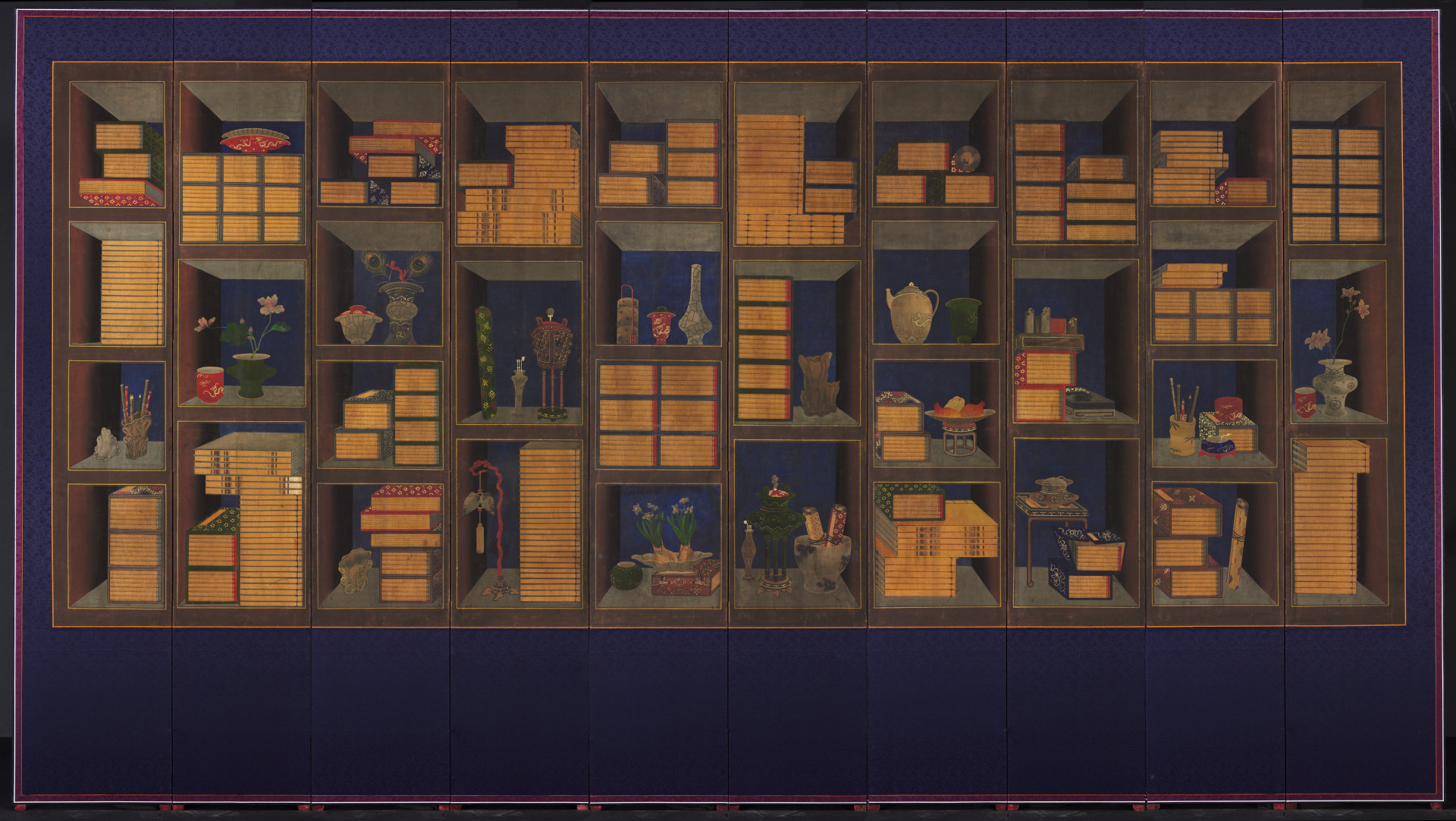
- Magazine Article
- Exhibitions
Chaekgeori
Books and other things in Korean painted screens

Chaekgeori: Pleasure of Possessions in Korean Painted Screens is the first exhibition in the United States to explore the wide artistic spectrum of a distinctive pictorial genre called chaekgeori (pronounced check-oh-ree). Translated as “books and things,” chaekgeori refers to a style of still-life painting that flourished in Korea from the late 18th century to the first half of the 20th. Chaekgeori exemplifies the illusion of three dimensions on a two-dimensional surface, and it is the earliest form of Korean painting to employ the European pictorial techniques of trompe l’oeil and chiaroscuro.
King Jeongjo, who ruled Korea from 1776 to 1800, is generally credited as the first patron of chaekgeori. According to the Collected Essays of King Jeongjo, when the king introduced his screen as a royal emblem, court officials mistook it for real bookshelves. Looking back behind the throne, King Jeongjo asked his officials, “Do you see them?” “Yes, we see them,” answered the officials. Then the king smiled and said: “These are not real books but paintings. Cheng Yi once said that if one occasionally entered one’s study and touched one’s books, it would please one, even though one was unable to read books regularly. I came to realize the meaning of the saying through this painting.”
The primary motif of chaekgeori was books, the objects Korean intellectuals traditionally associated with knowledge and social distinction. Chaekgado (literally, “picture of bookshelves”), a subgenre of chaekgeori, splendidly represents Korean aristocratic collectors’ zeal to amass books on diverse topics. Many Korean bibliophiles traveled to Beijing to acquire newly published books. The ten-panel folding screen that joined the Cleveland Museum of Art’s collection in 2011 is a rare example of chaekgado. Of the 35 shelves depicted, multiple volumes occupy 27 of them.

Books often share space with artful utilitarian objects carefully arranged in bookshelf cubbyholes. For example, the CMA screen also depicts stoneware with crackle patterns, bronze incense burners, Yixing clay teapots, a group of seals, colorful miniature rocks, and a plate of fragrant narcissus and citrons. Even European mechanical clocks were popular among Korean collectors. One of the screens in the exhibition pictures a rare image of a 19th-century Victorian Gothic Revival–style bracket clock.
What we see in chaekgeori is not a random assemblage of foreign luxuries, but rather a careful curation of objects that display a wide range of collectors’ tastes from scholarly to ostentatious. Toward the end of the 19th century, the nouveaux riches became major patrons of chaekgeori. The “popular” types of chaekgeori that decorated their homes are colorful and lively. Books were still painted, but they gave their prominence over to fruits and objects with auspicious symbolism. Succulent multiseeded fruits such as watermelons, pomegranates, cucumbers, and grapes convey a family’s strong aspirations for success and prosperity, as do handsome flowers such as peonies, chrysanthemums, and lotuses in full blossom.

The exhibition also includes two contemporary works by Kyoungtack Hong, who draws inspiration from the chaekgeori painting tradition as well as his own collecting habit. Both paintings address the human passion for collecting in a world of ever-growing global consumerism. In Library 3, Hong depicts an assemblage of things he’s collected, from Lego blocks to Barbie dolls. The claustrophobic space on the canvas brilliantly resonates with contemporary materialistic lifestyles that never entirely bring
fulfillment.
Cleveland is the final venue of the exhibition, which has already been hosted by the Charles B. Wang Center at Stony Brook University and the Spencer Museum of Art at the University of Kansas. At the Cleveland Museum of Art, Chaekgeori: Pleasure of Possessions in Korean Painted Screens will introduce our 10-panel folding screen along with new findings and interpretations. After examining a hidden seal painted on the screen’s third panel from the left, Prof. Byungmo Chung of Gyeongju University and the Overseas Korean Cultural Heritage Foundation and I discovered the artist’s identity. The screen is only the third known existing work by Yi Taek-gyun, a prominent royal court painter active in the second half of the 19th century.
